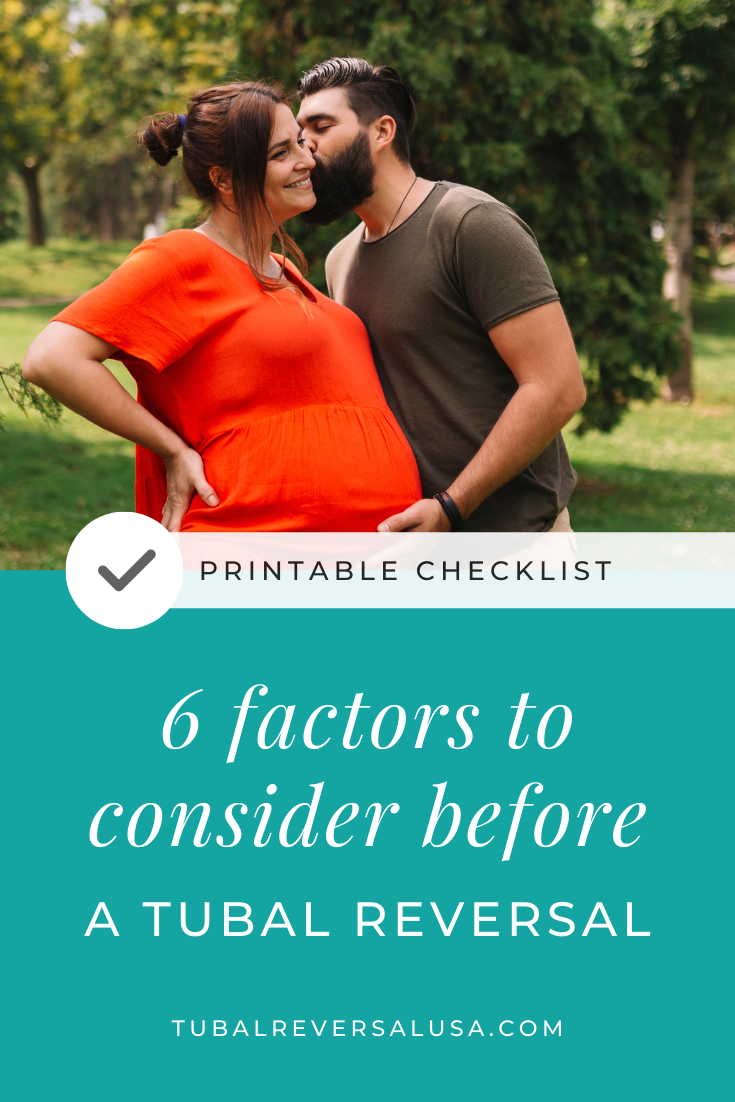Checklist: 6 factors to consider before a tubal reversal
We’ve all heard it, and it’s true: Change is inevitable. Despite feeling certain about the path we’re on, life frequently throws us a curveball! This is true of everything from career choices to major health and family decisions — and it’s what leads many couples to consider a tubal reversal.
When women choose to have a tubal ligation, they do so with every intention of it being permanent. Many things can lead to a change of heart, such as a new partner or simply a different outlook.
As we encounter change in our lives, we must be allowed to adapt. If you made a decision about the future of your family and now want to consider other options, you’re not alone.
Tubal reversal is a safe, effective option for most women who want to conceive naturally, without IVF. However, there are many important health and life factors to consider when determining if you’re ready to take this step.
You may be ready for a tubal reversal if…
1. The type of tubal ligation you had is reversible.
There are many types of sterilization procedures, and not all are easily reversible. The first step is finding out what kind of procedure you had, and how much length of tube was removed.
The operative report from the surgeon who performed the procedure will frequently tell us what we need to know. If 2.5cm or less of tube was removed, the procedure is often reversible. You can request this report from the facility or physician who performed your sterilization.
Women often undergo postpartum tubal ligations during a cesarean section or following a vaginal delivery. These types of ligations are typically reversible.
Other readily reversible procedures include fulguration or “burning” of the tube, fallope rings and clips because these damage the least amount of fallopian tube.
Some types of sterilizations are not well-suited for reversal. In vitro fertilization (IVF) is the best and only option for these patients. Similarly, patients who have had a salpingectomy, which is a total removal of the tube(s), should also consider IVF.
2. You’d like to get pregnant naturally, instead of through IVF.
Many women are naturally fertile before their sterilization and simply want to restore their body’s natural ability to conceive. Though IVF is frequently an option for sterilized patients, many perceive it as a high-cost and complicated process.
By comparison, tubal ligation reversal is an outpatient procedure which lasts around one hour.
It involves a small bikini incision and a short recovery period. You can even start trying to conceive the very next month!
3. You’re otherwise healthy and fertile.
Maybe you were fertile when you had your sterilization performed – but things can change, and it takes two to tango!
Simply reversing your tubal ligation isn’t a guarantee that you’ll get pregnant easily. There are many other factors that could impact your ability to conceive and carry a child.
First, your doctor will look at your overall health, including your age and BMI. Ideal candidates for a tubal reversal are 44 years of age or younger, with a BMI under 38.
Then, your doctor will order blood work in the form of a prenatal panel to check for any potential fertility issues.
For patients with male partners, we also strongly encourage sperm testing to rule out any male factors that may prevent natural pregnancy. But it’s your call whether to order this testing — we don’t require it.
If you meet the criteria for tubal reversal and your fertility doctor gives you a clean bill of health, you’re physically ready to undergo the procedure!
However, if a male or female infertility factor is uncovered at this stage, your doctor may recommend another treatment instead, like IVF or effortless IVF® (our more natural and affordable IVF option). Either way, we’ll put you on the path most likely to give you the result you desire.
4. You can afford or get funding for the treatment.
For most patients, any kind of surgery is a big expense. There are doctor’s fees, the facility fee, anesthesia — it all adds up quickly! It’s important to know exactly what you’ll be paying before you agree to a procedure.
That’s especially true for tubal reversals, because the procedure is usually not covered by insurance. Most patients pay for their treatment out-of-pocket, or take out a loan. There are several third-party lending companies that specialize in helping patients pay for healthcare expenses.
At CARE Fertility, a tubal reversal for patients without insurance coverage costs $9,000.
That includes the surgeon’s fee, the facility fee (certified ambulatory surgery center), anesthesia, and the telehealth consultations you’ll have with your doctor before and after the procedure.
The only costs that aren’t included in the $9,000 fee are your initial office visit ($350), your pre-screening blood work or prenatal panel ($140), and a semen analysis ($100) for male partners.
Even though tubal reversal surgery is a relatively affordable treatment option, it can still feel out of reach for many patients. If the financial cost of the surgery is a concern, there are resources available to assist you.
5. You can stay home from work for a week or two to recover from the surgery.
As surgeries go, tubal reversal is relatively simple and doesn’t require a significant amount of recovery time. As an outpatient procedure, tubal reversal patients are in and out the same day — no hospital stay required.
But that doesn’t mean you won’t need a little time off from work, and that may not be easy for everyone to arrange.
Most patients with sedentary jobs that don’t require heavy lifting, like many office jobs, can return to work in 5 to 10 days. For those who work from home, you’ll probably feel well enough to work within a few days.
You will experience postoperative discomfort and the doctor will prescribe you a narcotic pain medication to take for the first couple of days.
If you’re able to spare a few paid or unpaid sick days or vacation days to rest up and recover, you may even relish the forced relaxation. Enjoy it while you can, because from there, you’ll be ready to start trying for a pregnancy with your very next cycle!
6. You’re emotionally committed to growing your family and feel ready to take the next step.
If you’re physically a good candidate for a tubal reversal, and you can make time and room in your budget for the procedure, congratulations – you can “check the boxes” with confidence.
But ultimately, this is a very personal decision, driven by the heart. It doesn’t matter what friends or family think, and there’s nothing wrong with changing your mind. Only you and your partner know what will make you happiest and what the size of your family is meant to be.
No matter what you decide, CARE Fertility is here to help.
During your first telehealth appointment, your doctor will listen to your story and review your medical history. They’ll then talk through all of your options with you and help you weigh the pros and cons. Because we provide comprehensive medical care with a full range of treatment options, there’s no need to seek out another doctor if it turns out that a tubal reversal is not right for you.
When you’re ready, click below to schedule your first appointment with one of our doctors.








